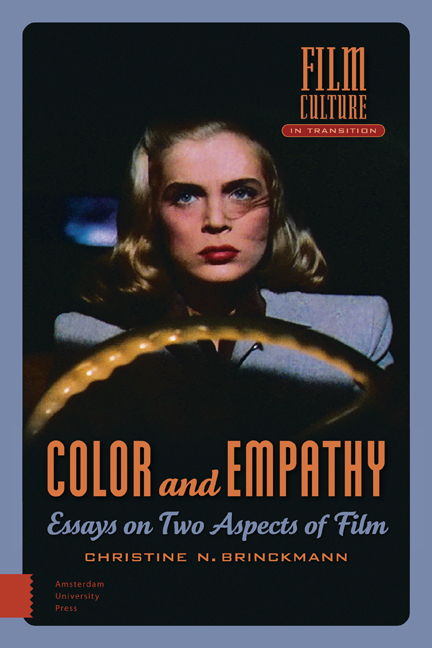Book contents
- Frontmatter
- Contents
- Preface
- Dedication
- Cinematic Color as Likeness and as Artifact: [2001]
- Chords of Color: [2006]
- The Tension of Colors in Colorized Silent Films: [2001]
- Structural Film, Structuring Color: Jenny Okun's Still Life: [1995]
- Desert Fury: A Film Noir in Color: [2012]
- The Work of the Camera: BEAU TRAVAIL: [2005]
- Empathy with the Animal: [1997]
- Motor Mimicry in Hitchcock: [1999]
- Abstraction and Empathy in the Early German Avant-garde: [1997]
- The Role of Empathy in Documentary Film: A Case Study: [2005]
- Genre Conflict in Tracey Emin’s Top Spot: [2007]
- Viewer Empathy and Mosaic Structure in Frederick Wiseman’s PRIMATE: [2009]
- CASTA DIVA: An Empathetic Reading: [2008]
- Publication Data
- Index of Films
- Index of Subjects
- Film Culture in Transition
The Work of the Camera: BEAU TRAVAIL: [2005]
Published online by Cambridge University Press: 23 June 2021
- Frontmatter
- Contents
- Preface
- Dedication
- Cinematic Color as Likeness and as Artifact: [2001]
- Chords of Color: [2006]
- The Tension of Colors in Colorized Silent Films: [2001]
- Structural Film, Structuring Color: Jenny Okun's Still Life: [1995]
- Desert Fury: A Film Noir in Color: [2012]
- The Work of the Camera: BEAU TRAVAIL: [2005]
- Empathy with the Animal: [1997]
- Motor Mimicry in Hitchcock: [1999]
- Abstraction and Empathy in the Early German Avant-garde: [1997]
- The Role of Empathy in Documentary Film: A Case Study: [2005]
- Genre Conflict in Tracey Emin’s Top Spot: [2007]
- Viewer Empathy and Mosaic Structure in Frederick Wiseman’s PRIMATE: [2009]
- CASTA DIVA: An Empathetic Reading: [2008]
- Publication Data
- Index of Films
- Index of Subjects
- Film Culture in Transition
Summary
Claire Denis is an auteur who works in close collaboration with an established team. This makes it both difficult and methodologically questionable to break down her films according to elements attributable to individual team members. Camerawoman Agnès Godard, whose work I intend to address here, has of course collaborated with other directors as well, including Agnès Varda and Erick Zonca, so to some extent one could extrapolate her personal style; and she is a highly articulate artist capable of explaining her decisions. Godard has expressly emphasized that with BEAU TRAVAIL (FRANCE, 1999), and in other films of Claire Denis, she contributed to the development of the filmic concept almost from the beginning, just as she was present in the cutting room after the conclusion of principal photography. As a cameraperson she is thus integrated into the entire project, even into the work of the actors and the selection of the music. This applies as well to other members of the team, each exerting an influence on the style of the film, such that all of the branches of filmmaking mesh smoothly with one another. In the analysis of a Claire Denis film, this aspect of mutual collaboration has to be kept in mind, and it is especially advisable to approach the camerawork together with the mise-en-scene and the montage.
On the other hand – and this does not contradict what has been stated above, as it expresses a very specific way of working – Agnès Godard enjoys a great deal of freedom with Claire Denis. After months of intensive joint preparations for a film, spontaneity is allowed during the shooting. Improvisation can take place because creative convergence is guaranteed by a deep overall understanding shared among the members of the team. The direction and the camera have a close relationship of trust: “Il y a entre nous une complicitè et un rapport passionnel etrange, une intimitè dont le centre est le cinèma.” Thus Agnès Godard understands herself not as a functional tool carrying out a task but as someone who, within the context of a collaborative project, performs independent work that remains, and should remain, tangible as such.
- Type
- Chapter
- Information
- Color and EmpathyEssays on Two Aspects of Film, pp. 109 - 124Publisher: Amsterdam University PressPrint publication year: 2014



